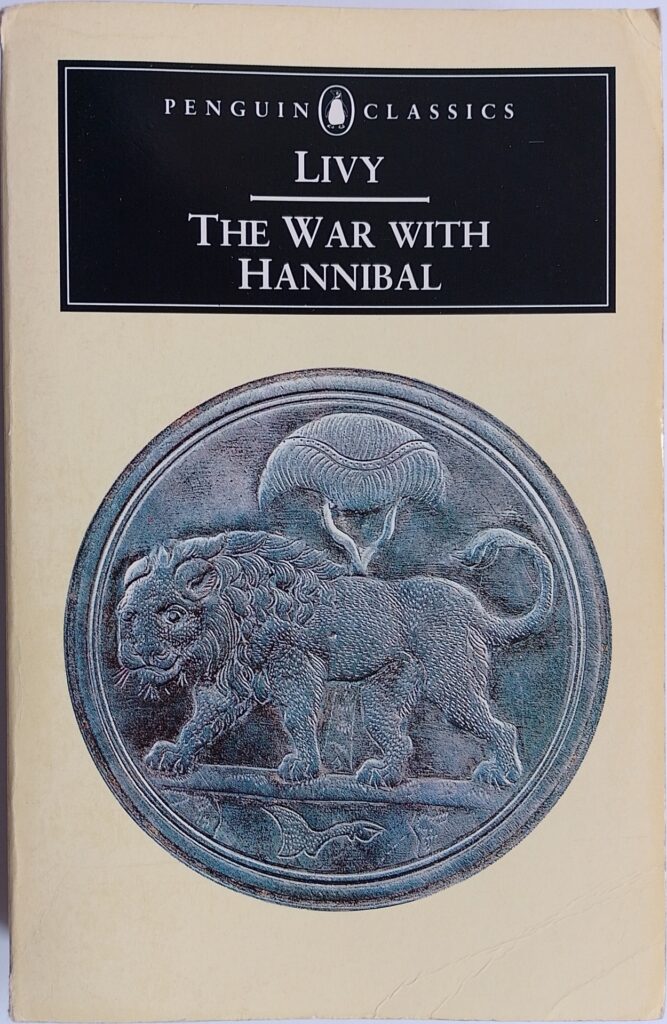(Books XXI to XXX)
First published c.20 B.C. Penguin, paperback, translated by Aubrey de Sélincourt, 1972, pp 711, c.270,000 words (main text).
We all know that Hannibal crossed the Alps with elephants, but what else can we remember about these events? For me, only a few other names from the period and the names of some battles; but the context had gone. Here Livy gives us the full story of the second Punic War between Rome and Carthage. The outcome of that war shapes the western world today. Our languages might well be based on Punic rather than Latin, for example, if the war had ended differently, as it might well have done.
Livy was not a historian in the modern academic sense. He did almost no primary research but based his history on the writings of others, some of whom, like Polybius, had spoken to people who had first-hand experience of the events. There were also extensive temple documents to draw on that recorded for each year the officials appointed or elected, as well as (presumably) other events of importance to the religious institutions, such as ‘unnatural events’ and the rites performed to propitiate them. Some of these sections, included for each year, read like shopping lists, but what they do tell us is how Roman society was organised at the time. The two consuls elected each year were the supreme leaders of the city and its satellites for war, religion and the upholding of the law, although by this stage they were surrounded by other officials who held specific responsibilities in their elected areas. What this meant was that Hannibal faced an ever-changing cast of generals over the seventeen years of the war (218-201 B.C.), with some exceptions as successful or popular generals had their particular commands extended.
Hannibal was the son of Carthage’s leading general who bitterly resented that city’s loss to Rome of Sicily and Sardinia as a result of the first Punic war. On the death of his father and uncles, he took over as Carthage’s leading general. He was still young when he started out from Spain with a huge army to destroy Rome. Crossing the alps cost him much of his army but he manged to restore it with Gauls from what is now northern Italy. He then inflicted a series of catastrophic defeats on the Romans, largely through superior tactics; his favourite being to lure the opposing army into a trap. This cumulated in his famous victory at Cannae in 216 B.C. over the inexperienced, populist and gung-ho Roman general Varro who was in charge of both consular armies on that day. What has puzzled historians ever since is why Hannibal failed to follow up by immediately marching on Rome.
Livy gives us quite a few of speeches by important characters at critical moments. Presumably he made these up, but they are fine pieces of writing. Livy apparently was interested in producing literature rather than an exact historical record. It makes the book generally a compelling read, although his chosen structure – a year-by-year record – sometimes gets in the way of a smooth flow because the war went on simultaneously in up to five theatres: Mainland Italy, Spain, Greece, Sicily, and Sardinia.
This translation makes for easy reading. According to the introduction, de Sélincourt could read a paragraph of Livy’s Latin and then, without further reference, write a fluid English translation. The scholar who wrote the introduction has no quibbles with the result. I was amused by a couple of the translator’s footnotes: For example, Livy writes prudishly at one point (p479) about the song of twenty-seven virgins in a parade saying “The words of the hymn were no doubt good enough for those rude and uncultivated days, but if I were to quote them now they would sound unpleasing and graceless.” de Sélincourt’s footnote to this says “A regrettable decision: they would be of very great interest.”
© William John Graham, August 2022

